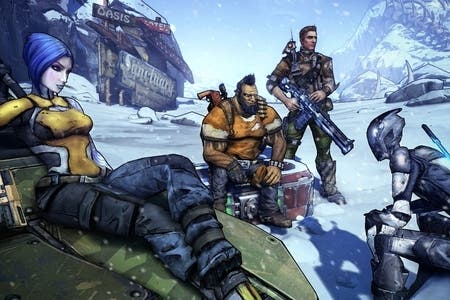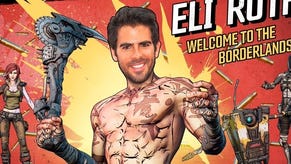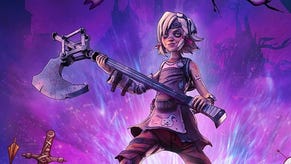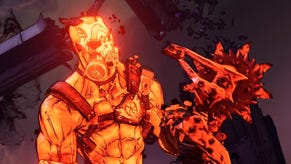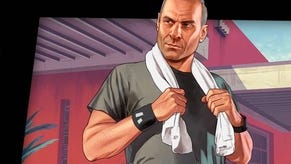Borderlands 2 review
Das Loot: The original and all DLC reviews, to mark the GOTY Edition's release.
Dishonored wasn't the only game to get a Game of the Year Edition last week; Borderlands 2 also saw the release of a complete edition featuring all the DLC campaigns and other add-ons, including two character classes, the Mechromancer and the Psycho. Here we present our original review from 18th September last year with, down the left-hand column, links to reviews of all the DLC and some further reading.
If you want to understand the spirit of Borderlands 2, close your eyes and imagine a swamp. In the middle of the swamp is a little shack that sells soda pop and tickets to an alligator zoo, and on the roof of the shack stands a wiry old duffer in denim britches and a dirty cap. He's made wings for himself from rusty trash cans, though, and he's rigged up a rocket engine from parts of an old moonshine distillery and the motor of a 1967 Ford Galaxie. With the squeeze of a jerry-rigged throttle it powers him up out of the swamp and high into the sky, where he tears through the Earth's atmosphere and then bellyflops explosively into the heart of the sun.
Borderlands 2 is still a hillbilly moonshiner sort of game, then, but it's the hillbilly at his canny, tinkering, big-dreaming best. It's the hillbilly at the peak of his powers. It's the hillbilly made majestic.
That's the spirit that made the first Borderlands great, too, of course, and that really came to the fore during the original game's add-on instalments. Dr Ned, General Knoxx, Claptrap's ramshackle uprising - these are the things that Borderlands 2 builds on the most, taking cues from the tighter campaigns, sharper jokes and more poignant, oddball asides. Questing, levelling, shooting, even driving: almost everything important has been improved while each little detail has been refined. Gearbox's latest offers the richness and character of those Halloween Special-styled episodes spread across a campaign that will take you days to complete.
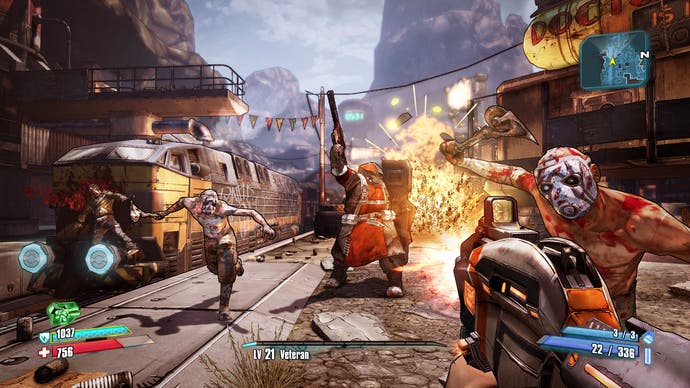
The plot concerns Handsome Jack of the Hyperion Corporation, who's built a base on the moon and is stirring up trouble on Pandora itself as he searches for one last great vault buried deep beneath its surface. By day, the highways and plains of this scrapheap world are covered with billboards showing his smirking mouth and his mocking eyes. By night, his troopers enforce draconian laws while the ground shakes with the sound of his treasure-seeking drills.
It's a surprisingly good narrative, but it's not the real story at all. The real story is different for everyone, and for me it was about a man who was constantly waddling into battle slightly under-levelled and who really wanted to get his hands on a corrosive shotgun. The man was me, and the story had a happy ending. I finally hit the right level for the run-up to the end-game boss, and I finally found that shotgun I was after, too. Then I killed an awful lot of people with the corrosive bullets it contained.
It's obvious, but it bears repeating: the weapons are at the heart of Borderlands, and they're a good place to examine the sort of tweaks that have been made throughout this pinwheeling, high-colour sequel. The primary difference is that guns are now easier to tell apart, with Gearbox's number-crunching Air-Fix algorithms clipping together some unique blasters for you as you work through the campaign and the endless, throwaway side-quests.
The manufacturers now stand out from each other with greater vibrancy, whether it's the gilt-edged Wild West mechanics of a Jakobs gun or the terse military bursts of a Dahl. I had a genuine argument with a friend over whether or not it was worth going into battle with Bandit stuff equipped (all of which is hacked together out of beer bongs and busted radio parts, by the looks of it, but benefits from huge ammo reserves and warpaint decals that invoke the grinning snouts of an old Spitfire).
The feel of each company's output, coupled with the range of different weapon types, is now distinct enough to really change the pace of play. Favour Jakobs? You'll spend your life fanning the trigger and managing the kickback as you let rip on Skags and robots alike. More of a Tediore man? Your reloads become explosive as you finish a clip, chuck each junky weapon at an enemy, and then watch it erupt as a fresh piece of kit strobes into life in your hands.
There are more reasons to search high and low for just the right gun this time because the elemental effects have been played up considerably - providing an even greater tactical motive to have an electrical SMG around to take down those shields before your corrosive pistol cuts through the armour, for example. In the end, though, the genius of Borderlands is that it gives you guns you didn't even know you were looking for. Keep your eyes peeled at all times, in other words, particularly if you're playing co-op with "friends": the loot is all shared, and the fastest scavenger gets the best of each windfall.
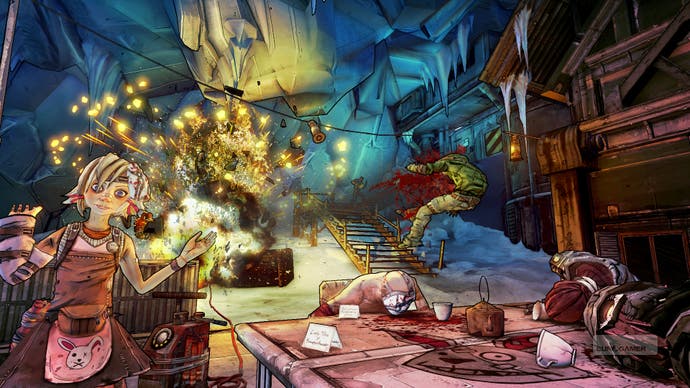
The classes benefit from the same polish, refinement and artful distinction. Each of the four main characters still offers three skill trees arranged around a single class-specific ability, but those abilities are punchier from the off and the ways you can tailor them are both more nuanced and more excessive. The new Siren has phaselock instead of phasewalk, for example, transforming her from the scarpering specialist to the team's crowd-control hardnut. Phaselock allows her to grab an enemy and hold it aloft so its hide can be riddled with bullets. Over time, she'll be able to heal at the same time and even reprogram foes as she locks them, while the Gunzerker can dual-wield weapons for short bursts, hot-swapping guns for combos, added damage and reload boosts.
Elsewhere, the Assassin's the new phasewalker, in many ways, with a deception move that lets him draw enemy fire to holograms while racing secretly through the environment handing out finishers - there's even an option to regain health as he's dotting about - while the Commando, who should be the boring solo-friendly turret class, can throw grenades when he's bleeding out if you so wish, or spawn an entire second turret. Oh yes, you can get that turret to fire a nuke, too, if you pile your points in right. The new guys feel both quirkier and more boldly realised than the original game's heroes; they're the perfect fit for a game that revels in quirk and in the freakishly lurid at all moments.
Each class is capable of showing you a good time if you're playing solo, but while the campaign's definitely been tweaked to make it flow in a more engrossing manner for a lonely vault-hunter, it's clearly designed around groups. Complimentary skills come together beautifully as phaselocked enemies are lofted up for nuclear turrets to unload on, say, and each class expresses itself in a particular rhythm as they race across the battlefield. The Assassin moves in short, invisible bursts; the Gunzerker makes the most of a quick recharge as his firepower options blossom and then fade every other minute or so.
Bring in a new player and they'll level up swiftly as they share your XP. They'll also benefit from the Badass ranking system, which rewards specific challenges with stat boosts linked to the player rather than the current character they're using. The only real annoyances are that menus still don't work that well if you're in split-screen and that a little bit of campaign progress can occasionally be lost if you dive into a friend's game and then head back to your own again.

Weapons and classes have always been Borderlands' specialities, of course. Enemies were one of the weaker links, however, so the improvements made here really count. The AI's still fairly basic, but you're often now thrown in amongst a nice Robotron-y churn of foes and bosses, all with different behaviours and priorities. Huge Gun Loader robots head right towards you with their girder-shaped bodies seemingly fresh from Transformers action figure packaging, while drones rove the skies overhead, looking for damaged units to repair. Some baddies explode when they expire and some call in reinforcements. Some even manufacture those reinforcements right in front of you, while human troopers dive in and out of cover, complicating matters further.
All of which means that battles tend to start pretty busily and can get out of hand with punishing speed if you're not careful. Prioritising targets is a must if you're going to stay alive, and when the really big guys turn up - the Volatile Crystalisks, say, who march through the acid lakes of the Caustic Caverns, each foot encased in a protective shield of gold - you have to be prepared to drop everything and regroup.
With all of Handsome Jack's robots stomping about the place, there's a definite bias towards carrying lots of corrosive weaponry around to melt their plating, but by the time you're into the second half of the story you'll have met plenty of organics, too: the likes of bandits and Skags, of course, and new guys like Bullymongs, many-armed gorilla variants who look like weaponised versions of Vishnu after a night chugging energy drinks to a looping mix-tape of the world's lamest sports metal.
The added complexity ensures that battles are utterly relentless in Borderlands 2, and the campaign focuses the chaos brilliantly, delivering the hectic precision of an FPS with the churn and pace of an MMO. Story missions are now a little more dynamic, with your agenda often changing over the course of a set-piece and your hand-ins offering a choice of outcomes and rewards, but the side quests are where it's really at. They step aside from the straight-ahead menace of Handsome Jack and allow you to revel in the dusty corners of this gloriously ramshackle world of hicks, palookas, tool-heads and reprobates.
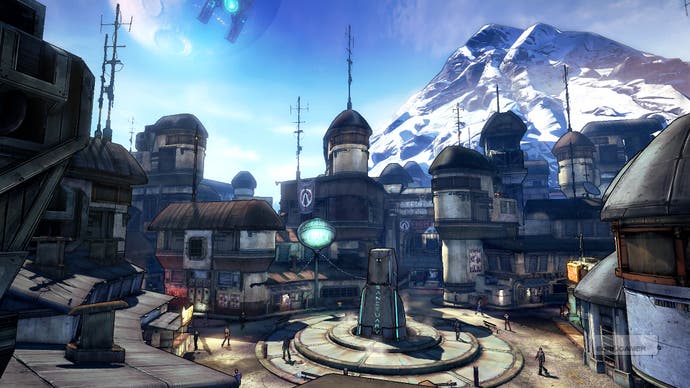
The texture of Pandora has grown as varied as the bestiary, in fact, and it all fuels the quest-lines. There's a proper hub city now, bristling with missions both deadly and - sometimes - kinda awkward, and there's a real range to the planet's vistas, whether it's the frozen wastes of the game's first act or the sci-fi ridges and lava-fields that emerge as you approach the finale.
Vehicles still feel like a bit of a missed opportunity, but at least they allow you to zip around at speed from one map to another, soaking in the greater draw distance and sharper, pulpier, more colourful aesthetics. The place names invoke the dangerous frontier of the 1800s and the kind of towns where the railway used to end. Sawtooth Cauldron, Lynchwood, Fink's Slaughterhouse: Borderlands could scarcely be more American if it tried, and like any good backwater redneck, it knows to keep its guns close at all times. If it moves, shoot it - and by the time that's taken care of, everything else seems to be moving, too. Shoot it all.
There are plenty of improvements, then, but the most satisfying thing to note is that Borderlands has lost none of its untidy charm in the transition from unlikely hit to megabucks tent-pole. The storyline runs a touch deeper now, but it's largely resisted the lunge towards the blandly epic - and while the art sparkles, it's ducked the big-team slickness that can rub away at a game's personality.
Compared to the dull, empty-eyed stoicism of so many triple-A games, it's still a welcome blast of idiot humour, too. How many other action-game heroes tackle enemies called Bullymongs by backing straight over them in a Hummer? How many others enter a room and chuck down a turret with a lofty shout of "Meet mah girlfriend"? And how many others fight through the scrum until their bullets are all gone and their quad-barrelled shotgun is click-click-clicking on empty chambers, yet can still look like they're having the best time of their ever-lovin' lives?
Bellyflop. Heart of the sun. Ka-boom.
